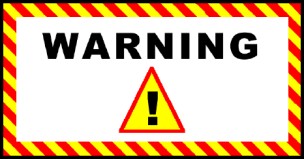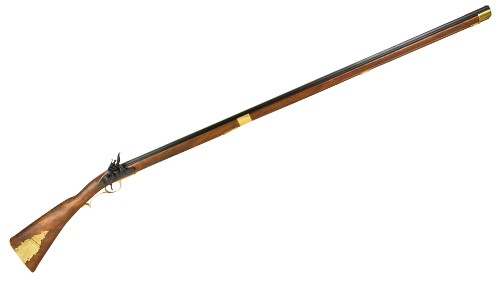


www.GunsOfOld.com -- Non-Firing Flintlock Musket Replicas


Copyright © 2008-2023 4G Company dba www.gunsofold.com
A 4G Company
Internet Store
Internet Store
Shop with confidence! Secure payment processing by PayPal
No PayPal account required!
No PayPal account required!
The musket--a smooth bore weapon with a polished surface inside the barrel--was not known for either distance or accuracy. An expert marksman would be lucky to hit a large target--such as a man or a deer--from 40 yards away. If the target was more than a hundred yards away, it was nearly impossible. Because of the weapon's inaccuracy, most fighting was done at close quarters, and the outcome of a battle was often determined by bayonet fighting. As much as 40% of the casualties in a typical battle using muskets were inflicted by bayonet.
A rifle, by contrast, has spiral grooves, or rifling inside the barrel. As a ball moves down the barrel, the grooves impart a spin to the ball which makes it fly more accurately toward its target. The barrel is narrower, so that gases from the exploding powder can not escape around the ball and more of the energy from the explosion goes into propelling the ball out of the barrel, carrying it a longer distance than a smooth-barrel musket can. With these advantages, a good marksman could hit a target with a rifle from several hundred yards away.
German gunsmiths perfected the technique of rifling in the 1500s. The concept was widely used by the early 1800s for hunting weapons, but not for military use. Why? It all came down to speed of loading and firing.
Both rifles and muskets prior to 1850 were muzzle-loaded. A powder charge and ball had to be put into the end of the barrel and pushed down the barrel to the firing mechanism. This was simpler and faster in a smooth-bore musket, with its larger barrel. Both powder and ball traveled readily down the musket barrel. But pushing the same ball down a tighter-fitting rifle barrel took longer and required a ramrod, so the musket and rifle had substantially different rates of fire.
An experienced shooter could get off two to three shots a minute with a musket, but would be lucky to get one shot in three minutes with a rifle. While that was sufficient for hunting deer, it would be disastrous in a battle where charging infantry armed with bayonetted weapons were bearing down on you at a dead run. By the same logic that made the musket a superior weapon for war, it was virtually useless as a hunting weapon with its short range and poor accuracy. That's why the rifle didn't come into common use as a military weapon until the perfection of breech-loading technology--allowing shells to be loaded through a slot near the firing mechanism, rather than inserted through the muzzle, though backwoods sharpshooters from Kentucky and Tennessee used their so-called Kentucky rifles (though most were made in Ohio and Pennsylvania) to deadly effect in the Battle of New Orleans during the War of 1812, and later at The Alamo.
A rifle, by contrast, has spiral grooves, or rifling inside the barrel. As a ball moves down the barrel, the grooves impart a spin to the ball which makes it fly more accurately toward its target. The barrel is narrower, so that gases from the exploding powder can not escape around the ball and more of the energy from the explosion goes into propelling the ball out of the barrel, carrying it a longer distance than a smooth-barrel musket can. With these advantages, a good marksman could hit a target with a rifle from several hundred yards away.
German gunsmiths perfected the technique of rifling in the 1500s. The concept was widely used by the early 1800s for hunting weapons, but not for military use. Why? It all came down to speed of loading and firing.
Both rifles and muskets prior to 1850 were muzzle-loaded. A powder charge and ball had to be put into the end of the barrel and pushed down the barrel to the firing mechanism. This was simpler and faster in a smooth-bore musket, with its larger barrel. Both powder and ball traveled readily down the musket barrel. But pushing the same ball down a tighter-fitting rifle barrel took longer and required a ramrod, so the musket and rifle had substantially different rates of fire.
An experienced shooter could get off two to three shots a minute with a musket, but would be lucky to get one shot in three minutes with a rifle. While that was sufficient for hunting deer, it would be disastrous in a battle where charging infantry armed with bayonetted weapons were bearing down on you at a dead run. By the same logic that made the musket a superior weapon for war, it was virtually useless as a hunting weapon with its short range and poor accuracy. That's why the rifle didn't come into common use as a military weapon until the perfection of breech-loading technology--allowing shells to be loaded through a slot near the firing mechanism, rather than inserted through the muzzle, though backwoods sharpshooters from Kentucky and Tennessee used their so-called Kentucky rifles (though most were made in Ohio and Pennsylvania) to deadly effect in the Battle of New Orleans during the War of 1812, and later at The Alamo.
Muskets vs. Rifles - Which Would You Have Used?
Civil War Musket Replicas
Musket Replicas
Questions?
Email Us
(Click on envelope)
Call or Text:
479-276-0434
479-276-0434
See our Home Decor and Gift Ideas for Rev War and other history enthusiasts!



Site Index
Our selection of Revolutionary War and Civil War muskets are historically accurate, non-firing replicas of the flintlock muskets used by both sides in those wars. The massive British-made Brown Bess musket--used by both American colonists and the British army--is 75 inches long with the included bayonet attached, and weighs 6-1/2 pounds. Originally made at the famous St. Etienne gunworks, the French-made Charleville musket is 6 feet long with its included bayonet attached, and both it and its shorter cousin, the Charleville carbine, were supplied by France to the American colonists for fighting the British. The British-made Enfield 3-band musket and Enfield musketoon were commonly used by both Union and Confederate troops during the American Civil War.
#22-1067
#22-1046
#22-1054
#22-1036
#22-1037
Visit Us On facebook
American Revolutionary War Musket Replicas
Questions? Call or Text:
479-276-0434
Or Email:
479-276-0434
Or Email:
Home > Flintlock Musket Non-Firing Replicas
Charleville American Revolutionary War Musket
In Stock
In Stock
In Stock
In Stock
In Stock
In Stock



























































